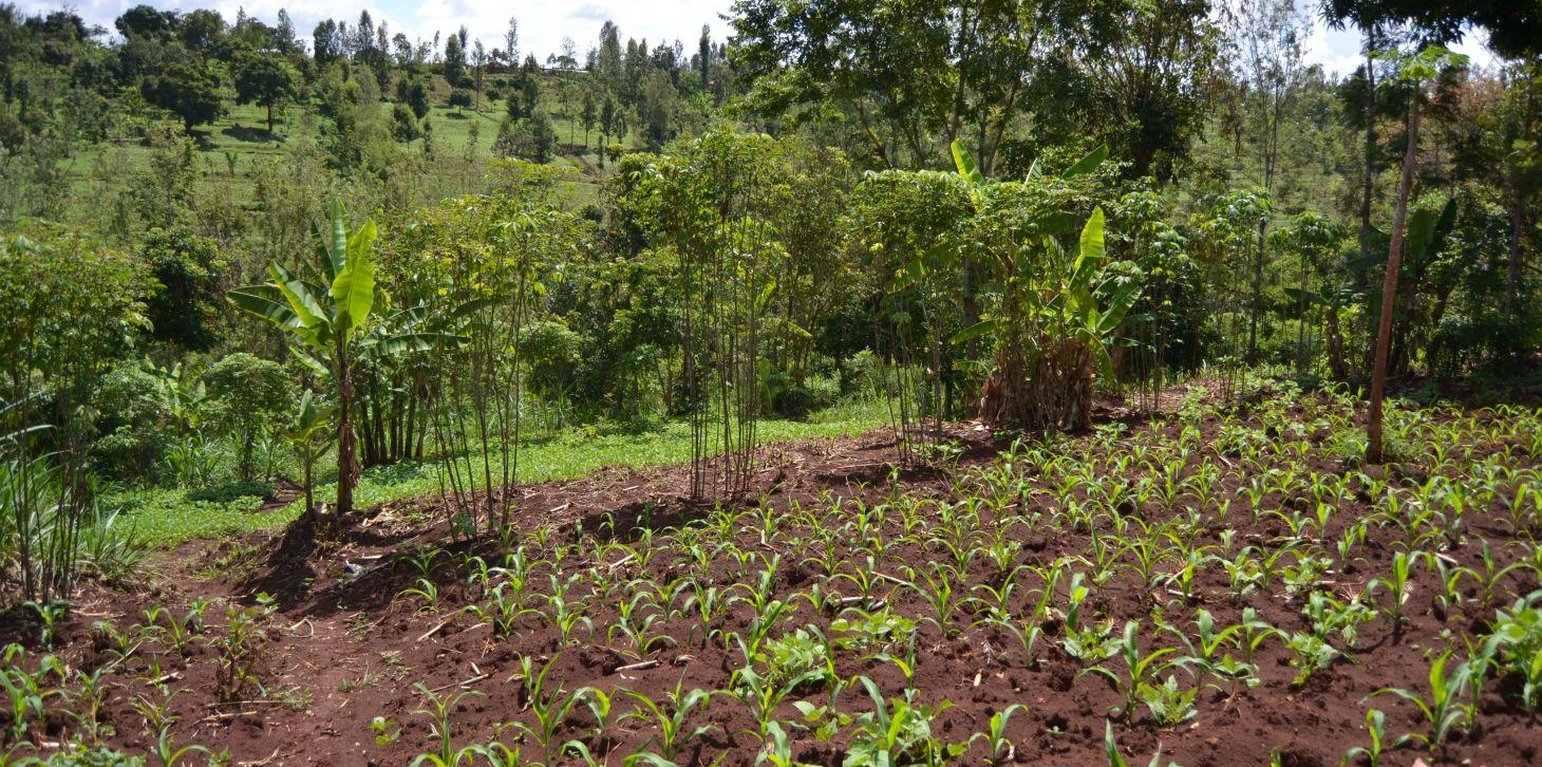



The Agroforestry system combines trees plantation (Bananas, Grevillea and Avocados) for fruits and timber collection with cereal crop, maize (Zea mays). Indeed, in order to increase yields, strip intercropping is practiced: cereal crop (maize) is grown in association with pulse (food legumes): beans. Instead of using expensive commercial fertilizers, beans could facilitate maize growth due to the possible transfer of N during growth or after incorporation of the legume biomass, during the growth period of the cereal (Sangakkara et al., 2003). Furthermore, soil quality (e.g. soil structure) is improved because of the increased amount of humus and organic matter and a better soil cover helps in preventing splash erosion and increase soil moisture content and therefore fertility. Indeed, beans have a beneficial impact for weed control (probably due to the shadow effects) and soil moisture content (Worfswinkel, undated; Odhiambo and Ariga, 2001). Planting different crops helps to diversify production and family food supply. Concerning SWC, hillside ditches have been created at the top of each 'terrace' and trees are also planted nearby and Cassava (a drought resistant plant) at the bottom. Manure/compost and organic fertilizers are supplied regularly both on maize/grass (twice a year) and Bananas (once), as good soil management practice. A higher level of organic matter in the soil indicates reduced bulk density, improved soil structure, aeration and higher water holding capacity (Olabode et al., 2007), which altogether improve the physical, chemical and biological properties of the soil (Haering and Evanylo, 2005). Bananas are planted in lines in the upper part of the land. The ditches, large 1m are excavated along the contour; they break slope into shorter segments 11 m long to intercept surface runoff. Ditches also help to prevent soil erosion and to avoid that nutrients and organic matter flow easily downwards into the river, instead they fall into the ditch. A live barrier of Napier grass is present above and below the edge of the five ditches, in two lines, to capture sediments and stabilize the structure, thus it is adequately protected. To conclude, a small area of the land is used to plant Napier grass only for fodder for grazing
Purpose of the Technology: Maize and beans are cultivated for home consumption while Avocados and Bananas are planted for economic (commercial) purposes. Fruits are sold out to the middle-men directly from the house (not at the market), to reduce costs (e.g. transport) and time. Avocados are sold at about 2.5/3 Ksh and Bananas at 200 Ksh. Grevillea trees are considered as saving, and sold out for timber production when the farmer is in need of cash, earning between 800 up to 1500 Ksh, depending on the size-lenght of the tree and the costs for cutting-transportation (e.g. machine operator). In general the selling of timber occurs per feet (running feet). ‘Whole” or standing tree is the preferred mode of selling trees from farms. Negotiation on sales is per tree ‘standing on farm’, with no processing or conversion. Buyers cut and cross cut, and carry timber from farms. Branches and slabs resulting from timber recoveries are left with the farmer depending on price negotiation; if the buyer carries these products then the price of the tree is adjusted upwards (Carsan and Holding , 2006; Holding et al., undated). Furthermore, the farmer underlined how 'bad prunings' at the top of the trees cause holes inside the trunks and thus a higher risk of fungi attacks and other diseases. The majority of the trees are planted along the boundaries of the land, for demarcation and only few are 'dispersed' on the cropland, to avoid excess of shadow to the cereal crop
Establishment / maintenance activities and inputs: High initial input to construct ditches and planting crop; manure also requires regular work: feeding cows and collect droppings and distribute them twice during the year, also over Napier grass. Dry planting is the preferred practice and the seeds are soaked the night before planting; this practice is advisable especially when the growing period is very short (Schmidt et al., 1983); organic fertilizers are applied over maize after 1 week and during the growing period (after about 18 days). Further maintenance is necessary after every rainy season to remove the sediments accumulated into the ditch and for pruning Grevillea, every three seasons. As mentioned above, pruning requires skills and knowledge to avoid plant diseases and labour is expensive because it is high risk work. The farmer trees plantation account for: 15 Avocados (from 4 seedlings), 100 Bananas (from cutting new suckers) and 50 Grevillea trees
Natural / human environment: The area is characterized by rolling-hilly slope and highly exposed to erosion and land degradation: planting trees protect the soil from nutrients leaching and create a litter which reduces evaporation during dry seasons. Concerning the variety of the trees, (e.g. Avocado) the farmer by grafting with better quality branches, improve the quality of the stock trees with certified variesties: out of 4 seedlings of Avocado (10 Ksh each), he has now 15 seedlings of the better (certified) variety called HASS, which performs well at 800-2100 m asl with well distributed annual rainfall of 1000-1200 mm (Youth Agro-environmental initiative website)
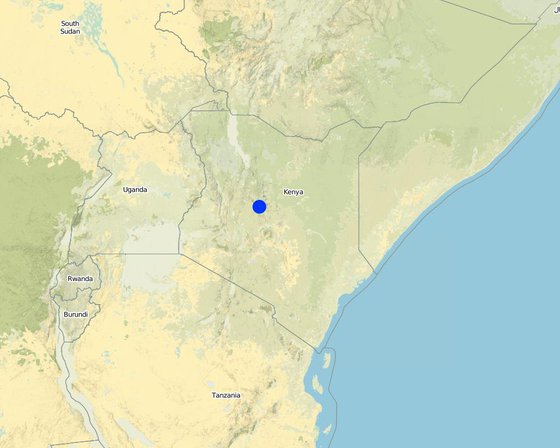
Местоположение: Muthithi location, Kagurumo sublocation, Central, Кения
Число исследованных участков, где применяется Технология:
Пространственное распространение Технологии: равномерно-однородное применение на определенной площади (0.008 km²)
На постоянно охраняемой территории?:
Продолжительность применения Технологии: менее 10 лет назад (недавняя)
Тип внедрения/ применения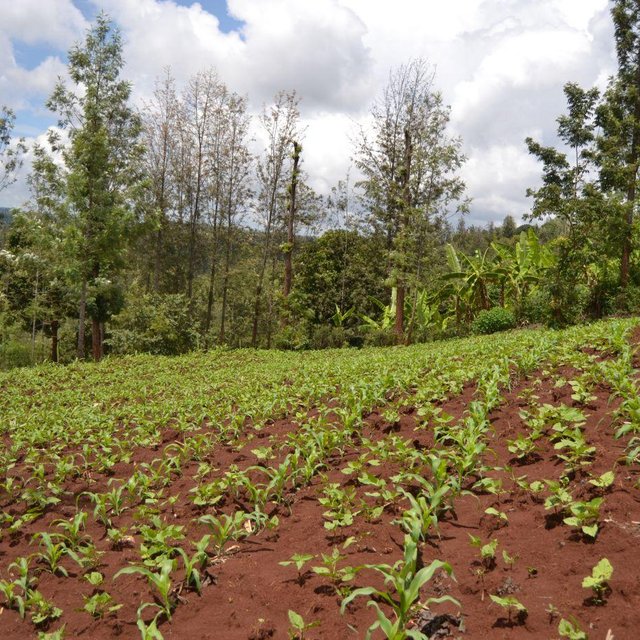
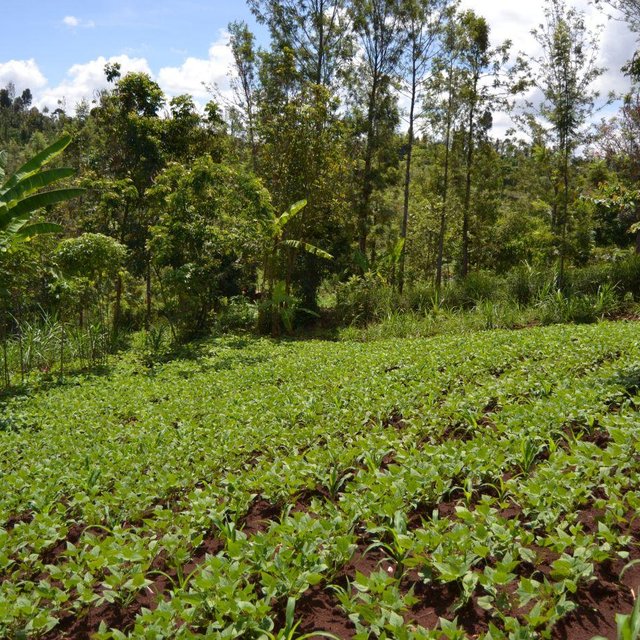









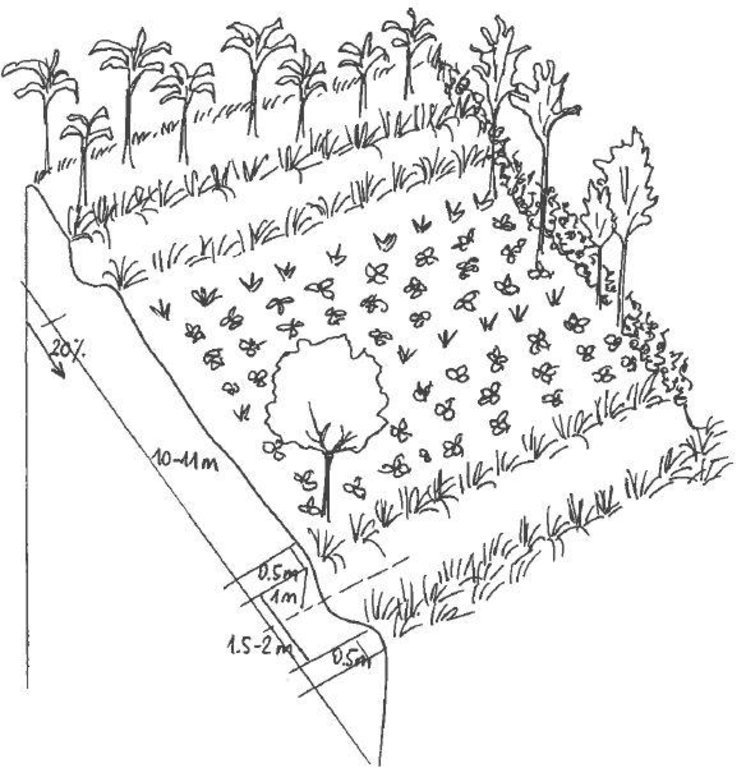
| Опишите затраты | Единица | Количество | Затраты на единицу (Kenyan Schellings) | Общая стоимость на единицу (Kenyan Schellings) | % затрат, оплаченных землепользователями |
| Оплата труда | |||||
| Digging the hole (3m×3m×1.5m) where to compost | person/days | 2,0 | 3,5 | 7,0 | 100,0 |
| Digging holes (1 feet ×1 feet) and planting trees | person/days | 2,0 | 3,5 | 7,0 | 100,0 |
| Establishment of the ditches (digging ditch and creating soil bunds donward) and terracing | person/days | 10,0 | 23,3 | 233,0 | 100,0 |
| Оборудование | |||||
| Machine to grill/mill maize leftovers (chap cutter) | piece | 1,0 | 1164,0 | 1164,0 | 100,0 |
| Generator | piece | 1,0 | 582,0 | 582,0 | 100,0 |
| Cow | piece | 2,0 | 349,0 | 698,0 | 100,0 |
| Посадочный материал | |||||
| Seedlings Grevillea | pieces | 54,0 | 0,1111 | 6,0 | 100,0 |
| Общая стоимость запуска Технологии | 2'697.0 | ||||
| Общие затраты на создание Технологии в долларах США | 31.4 | ||||
| Опишите затраты | Единица | Количество | Затраты на единицу (Kenyan Schellings) | Общая стоимость на единицу (Kenyan Schellings) | % затрат, оплаченных землепользователями |
| Оплата труда | |||||
| Prepare and apply fertilizers (organic) | person/days | 2,0 | 2,0 | 4,0 | 100,0 |
| Prepare manure+compost/mulch | person/days | 3,0 | 2,0 | 6,0 | 100,0 |
| Digging planting holes and planting grass | person/days | 6,0 | 2,0 | 12,0 | 100,0 |
| Maintenance (weed control and cutting Napier grass and collecting fodder) | person/days | 5,0 | 12,0 | 60,0 | 100,0 |
| Оборудование | |||||
| Fuel | l | 3,0 | 1,0 | 3,0 | 100,0 |
| Посадочный материал | |||||
| Seedlings grass (per ha) | pieces | 100,0 | |||
| Удобрения и ядохимикаты | |||||
| Organic fertilizer (Biodeposit Elixir) from Thika | ml | 12,0 | 1,0 | 12,0 | 100,0 |
| Другие | |||||
| Labour: Pruning branches and let them dry for firewood | person/days | 1,0 | 4,0 | 4,0 | 100,0 |
| Labour: Clearing the tree for selling timber | person/days | 1,0 | 7,0 | 7,0 | 100,0 |
| Labour: Repairing the ditches and remove excess of soil/leaves accumulated during the rainy season | person/days | 2,0 | 2,0 | 4,0 | 100,0 |
| Общая стоимость поддержания Технологии | 112.0 | ||||
| Общие затраты на поддержание Технологии в долларах США | 1.3 | ||||